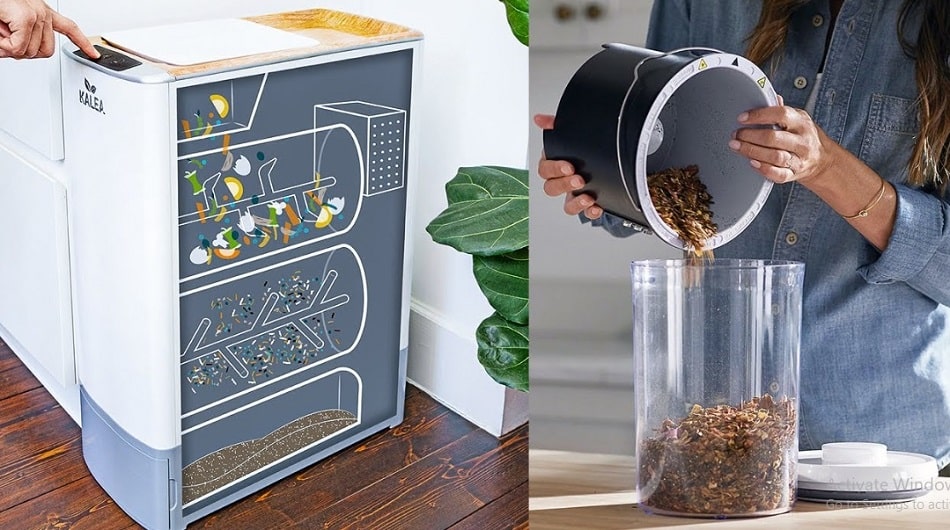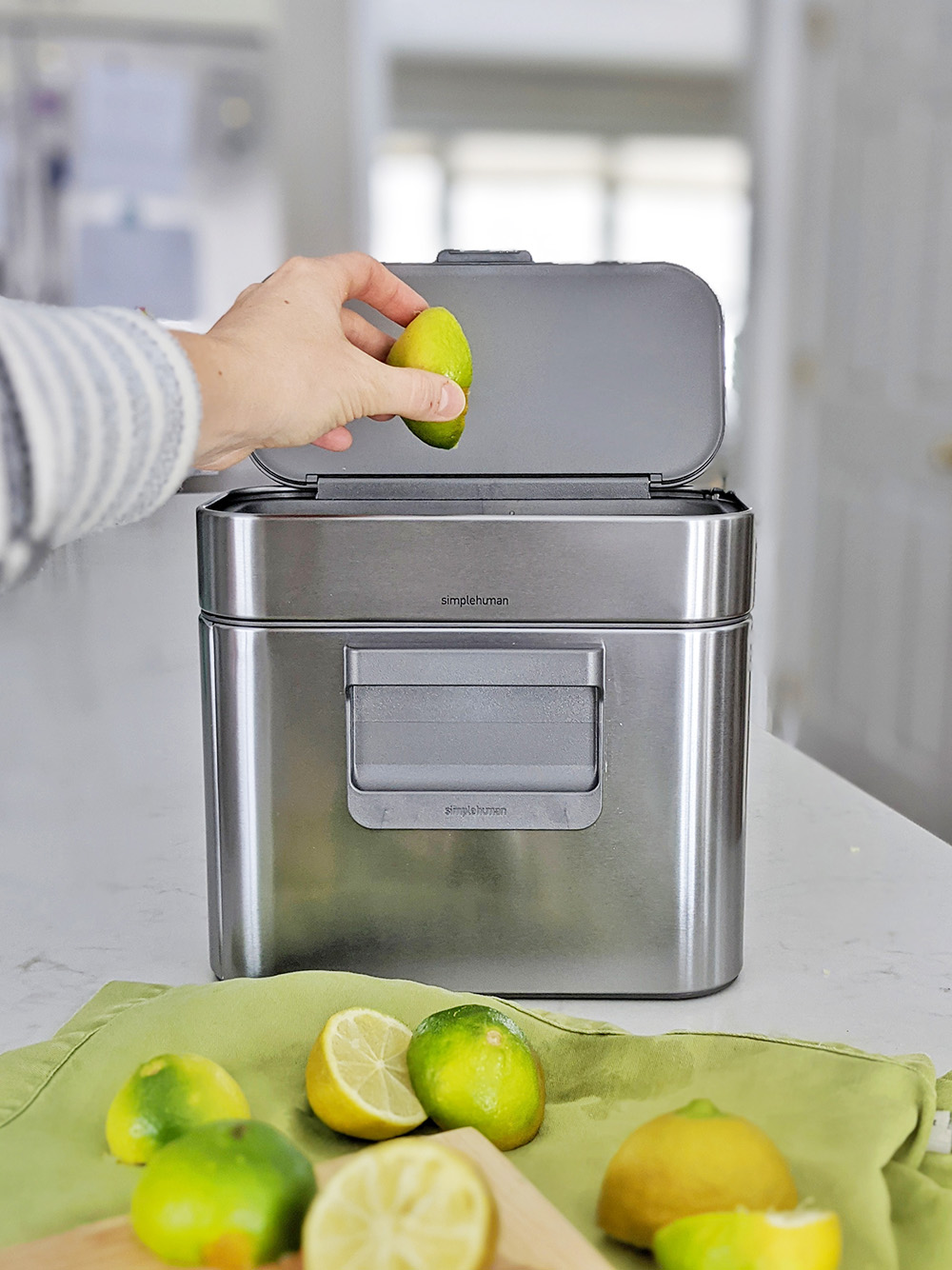How to Store Compost in Kitchen – Details Process You Should Know

Storing compost in the kitchen is a great way to reduce waste and provide nutrients for your plants. Here are some tips on how to store compost in the kitchen:
1. Collect food scraps in a container with a lid.
A small, covered container will do if you have a smaller household, but a larger one may be necessary if you have a lot of food scrap producers in your home. Be sure to clean out the container regularly to prevent smells.
2. If you have pets, make sure they cannot get into the container.
Pets can be attracted to the smell of food scraps and may make a mess of yourcontainer if given access.
3 . Place the container in a convenient location near where you prepare meals or where food scraps are generated .
This will make it easy for you to add scraps as you produce them , and will also help remind you to empty the container on regular basis .
4 . Add yard waste and other organic matter to your compost pile or bin as desired .
- Find a suitable container for storing compost in the kitchen
- A lidded plastic bin or bucket will work well
- Drill holes in the bottom of the container to allow for drainage
- Place the container in a convenient location in the kitchen, such as next to the sink or under the counter
- Collect kitchen scraps in a small bowl or container and transfer them to the larger compost bin when it is full
- Empty and clean the smaller bowl or container on a regular basis to prevent odors from developing
Storing Kitchen Scraps for Compost Dump and Save or Plant No Turn composting for a Great Garden
Where Should I Put My Compost Bin in My Kitchen?
There are a few things to consider when deciding where to place your compost bin in the kitchen. The first is proximity to the sink. You’ll want to be able to easily transfer food scraps from plate to bin, so placing it near the sink is ideal.
The second consideration is ventilation. Compost bins can produce odors, so you’ll want to make sure it’s placed in an area with good airflow. Lastly, you’ll want to think about accessibility.
You’ll need to be able to reach your bin easily when adding scraps or removing finished compost, so placing it in a convenient location is key.
Assuming you have these factors in mind, there are a few different places that would work well for a compost bin in the kitchen. One option is under the sink.
This keeps the bin out of sight and allows for easy transfer of food scraps from plate to bin. Another option is on the countertop near the edge of the sink. This provides good ventilation and also allows for easy access when adding or removing items from the bin.
Finally, another option is on a shelf or cabinet near the fridge. This location provides good airflow and keeps the bin within reach for when you’re cooking or cleaning up after meals.
Ultimately, there’s no wrong answer when it comes to where to put your compost bin in the kitchen – it’s all about what works best for you and your space!
How Can I Keep Compost in My Kitchen Without It Smelling?
If you’re interested in keeping a compost bin in your kitchen without it smelling, there are a few things you can do. First, make sure to keep your bin clean and free of debris. Second, add plenty of ventilation by drilling holes in the lid or sides of the bin.
Third, keep your compost moist but not wet by adding water as needed. Fourth, add plenty of green matter such as fruit and vegetable scraps to balance out the brown matter. Finally, don’t forget to turn your compost regularly to aerate it and help speed up the decomposition process.
By following these tips, you can keep your kitchen compost bin smelling fresh and earthy instead of foul and rotten.
Can You Keep Compost in the Kitchen?
If you’re interested in keeping compost in your kitchen, there are a few things to keep in mind. First, it’s important to have the right container. Second, you need to make sure the container is aerated so that the compost doesn’t become too wet and start to smell.
Third, you’ll need to add food scraps and other organic matter on a regular basis to keep the compost going. Lastly, you should monitor the temperature of your compost pile so that it doesn’t get too hot and break down too quickly.
Assuming you have all of those things covered, yes, you can absolutely keep compost in your kitchen!
Many people do it successfully every day. Just remember that it does require some effort on your part to make sure everything stays healthy and happy.
How Do You Store Compost Indoors?
If you’re lucky enough to have a backyard, storing your compost outdoors is as easy as finding a shady spot and piling it up. But if you’re like most of us, and don’t have that luxury, never fear—you can still compost indoors! Here’s how:
The first step is to find a suitable container. Your container should be made of breathable material, like wood or plastic, and large enough to hold all the scraps you want to compost (aim for at least 5 gallons). If you’re worried about critters getting into your compost, make sure your container has a tight-fitting lid.
Once you’ve got your container, it’s time to start adding scraps! You can add pretty much any organic matter to your indoor compost pile, including fruit and vegetable scraps, coffee grounds and filters, eggshells, tea bags, and even shredded paper. Just be sure to avoid meat or dairy products, which will attract pests and start to smell bad quickly.
When your container is full, give it a good stir every few days to help the decomposition process along. And that’s it! In 6-8 weeks (or longer), you’ll have rich compost ready to use in your garden or houseplants.

Credit: www.honestlymodern.com
Compost Bin Kitchen
If you’re looking for a way to reduce your kitchen waste, composting is a great option! And one of the best ways to compost is with a kitchen compost bin.
There are many different types of kitchen compost bins available on the market, so it’s important to choose one that will fit your needs.
For example, if you have a small kitchen, you’ll want to choose a smaller bin. If you have pets or children, you’ll want to make sure the bin has a lid to keep them out.
Once you’ve chosen the right bin for your kitchen, it’s time to start filling it up!
You can add just about any food scraps to your compost bin, including fruits and vegetables, coffee grounds and eggshells. Just be sure to avoid meat and dairy products, as they will attract pests and produce odors.
When your bin is full, simply empty it into your outdoor compost pile or bin.
Then start all over again! With a little bit of effort, you can greatly reduce your kitchen waste – and help improve your garden soil at the same time!
How to Store Compost Outside
Assuming you would like tips on storing compost outside:
If you live in an area with freezing winters, your options for storing compost outside are limited. The best option is to build a bin out of wood or concrete blocks that is at least three feet tall and three feet wide.
The bin should have a lid to keep the compost from getting wet and freezing. If you cannot build a bin, you can store your compost in black plastic bags. Be sure to poke holes in the bottom of the bag so that water can drain out.
Store the bags in a shady spot so they don’t get too hot and dry out.
In warmer climates, you can store your compost outdoors year-round. The key is to keep it moist so it doesn’t dry out and turn into dust.
One way to do this is to cover the pile with a tarp or piece of burlap cloth. Be sure to weigh down the edges of the tarp so that wind doesn’t blow it away. Another way to keep your compost moist is to add water regularly, especially during periods of drought.
Where to Store Compost Bin
A compost bin is a great way to reduce your waste and create nutrient-rich soil for your garden. But where should you store your compost bin? Here are a few things to consider:
1. Location: Your compost bin should be located in an area that is convenient for you. If you have a small yard, you may want to keep it close to the house. If you have a larger property, you may want to place it further away from the house to avoid any smells.
2. Shade: Compost bins need some shade to protect them from the hot sun. But too much shade will make the composting process go more slowly. Find a location that gets some sun but is also sheltered from the hottest afternoon rays.
3. Airflow: Good airflow is essential for proper composting. Be sure to place your bin in an area where there is plenty of air circulation. A spot next to a fence or hedge can work well.
4.. Drainage: It’s important that your compost bin has good drainage so that excess moisture can escape and air can circulate properly.
Freezing Kitchen Scraps for Compost
If you’re looking for a way to reduce your food waste and create nutrient-rich compost for your garden, consider freezing your kitchen scraps! Freezing kitchen scraps is an easy and efficient way to store them until you’re ready to compost. Plus, it can help slow down decomposition so that your compost is of the highest quality.
When freezing kitchen scraps, it’s important to chop them into small pieces first. This will help them break down more quickly once they’re added to your compost pile. You can also freeze them in bags or containers with a little water, which can help keep them from drying out.
Once you’ve collected enough frozen kitchen scraps, it’s time to add them to your compost pile! Be sure to mix them in well with other organic matter, such as leaves and grass clippings. This will help aerate the compost and speed up the decomposition process.
Adding frozen kitchen scraps to your compost pile is a great way to reduce food waste and create nutrient-rich fertilizer for your garden!
How to Compost at Home
Composting is a great way to reduce your waste and give back to the earth. It’s easy to do, and it doesn’t take much space or time. Here’s how you can start composting at home:
1. Collect your organic waste. This includes things like fruit and vegetable scraps, coffee grounds, eggshells, and more. You can either keep a small bin in your kitchen for this purpose, or put your waste directly into your compost pile outside.
2. Add some “brown” materials to balance out the green stuff. Brown materials include things like dead leaves, twigs, and newspaper. This helps with drainage and aeration in the compost pile.
3. Start layering! Alternate between layers of green and brown materials until you have a nice big pile going. Make sure to keep it moist – not too wet or too dry – by adding water as needed.
4. Turn the pile every week or so to help aerate it and speed up the decomposition process.
How to Collect Compost
If you’re interested in saving money and helping the environment, composting is a great way to do both. With a little bit of planning, you can easily collect compostable materials from your kitchen and yard waste. Here’s how to get started:
1. Find a location for your compost bin or pile. If you have a backyard, this is the ideal spot. If not, any sunny spot will do.
Just make sure the area is well-drained so your compost doesn’t get too soggy.
2. Start collecting materials for your compost. In the kitchen, save vegetable scraps, coffee grounds, and eggshells in a covered container.
You can also add paper towels and napkins (avoid those with plastic or wax coating), as well as leaves and grass clippings from outside.
What to Do With Food Scraps Without Composting
We all know the importance of composting. It’s a great way to reduce our environmental impact, and it’s also great for our gardens. But what if you don’t have a garden, or you’re not able to compost for some other reason?
Here are some tips for what to do with your food scraps without composting:
1. Give them to your local farmers market. They will often take food scraps from customers in exchange for fresh produce.
2. Start a worm bin. This is a great way to recycle your food scraps and turn them into nutrient-rich soil for your houseplants.
3. Donate them to a community garden.
If you don’t have space for a garden yourself, consider donating your food scraps to one near you. This is a great way to help out your community and reduce waste at the same time!
4. Use them as animal feed.
If you have chickens or rabbits, they will love eating your leftover vegetable peels and other food scraps! Just make sure that any meat or dairy products are properly cooked before feeding them to animals.
5.”Feed” your garbage disposal .
Garbage disposals grind up food scraps so they can be flushed down the drain, but they need something to grind against!
Kitchen Scraps Container
A kitchen scraps container is an important tool for any cook, whether you’re a beginner or a professional. They come in all shapes and sizes, but the basic idea is the same: to keep your food scraps organized and out of the way.
There are many different ways to use a kitchen scraps container.
Some people like to keep them under the sink, while others prefer to keep them on the countertop. Some containers have compartments for different types of food, while others are one large bin. No matter what style you choose, there are a few things to keep in mind when using your kitchen scraps container.
First, make sure that your container has a tight-fitting lid. This will help to prevent any smells from escaping and attracting pests. Second, empty your container regularly.
Depending on how much cooking you do, you may need to empty it every day or two. Finally, be sure to compost your kitchen scraps when they start to pile up!
A kitchen scrap container is a great way to reduce waste and stay organized in the kitchen.
By following these simple tips, you can make the most of yours!
Conclusion
If you’re looking for an easy way to store your compost, look no further than your kitchen! Here are a few simple tips on how to store compost in the kitchen:
1. Choose a location that is close to your garden or other outdoor areas where you will be using the compost.
2. Select a container that has a tight-fitting lid and is made of breathable material, such as burlap or cheesecloth.
3. Drill holes in the bottom of the container for drainage and aeration.
4. Fill the container with alternating layers of green and brown materials, such as grass clippings, leaves, and vegetable scraps.
Be sure to keep the material moist but not wet by adding water as needed.
5. When the container is full, seal it tightly and allow it to sit for several weeks so that the materials can break down into nutrient-rich compost.





